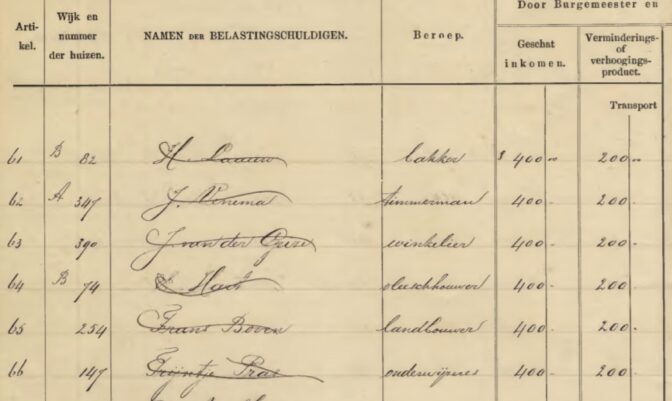In 1812, the Netherlands had more than 1,100 different municipalities. Since then, many have merged so we have about 350 left. See the Gemeentegeschiedenis website for an overview of all the municipalities that ever existed.
Each of these municipalities created a wide range of records. Typical categories include:
- Records created by mayors, aldermen, municipal council, such as minutes of meetings, correspondence, municipal reports
- Various departments within the municipality
- Personnel (civil servants, public school teachers, etc.)
- Property owned by the municipality, such as the town hall, schools
- Finances, including taxes
- Residents (population registers)
- Health and sanitation
- Safety and police
- Water management
- Economy (including permits)
- Welfare
- Education
- Defense (including militia records)
Typically, only the most popular of these records can be found online. The rest is available in the reading room of the local or regional archives, or can be ordered via scanning-on-demand.

Fragment of the Midwolda Head Tax records from 1901, showing a baker, carpenter, shopkeeper, butcher, farmer, and teacher, with their estimated income.


Yvette,
Awesome website!! This makes understanding the composition of cities in the Netherlands so much easier.
Thanks for sharing.
Yvette,
My first efforts in researching Dutch research have been a bit intensive with name variations and learning Patronymics as well as a bit of the Dutch language. I am impressed at how easy yet difficult it can be at times. Your tips and recommendations have really made the difference! Thank you!
I have arrived at a possible dead-end-and an intriguing puzzle:
I have an ancestor, Leendert Janse Moermond.
Using WieWasWie as the main source:
Leendert Janse Moermond, [baptized 22 Dec 1715-died bet 1754-1759]
married Jakoba de Vos [1722-1752] in 1742 and, after Jakoba’s death,
married Maria Oostakkers [abt 1725-??] in 1752.
Maria Oostakker [as spelled in banns] – the widow of Leendert Moermond – married Jan Holland [abt 1735?] on 23 Nov 1759.
The dead-end: Leendert’s date of death:
I can estimate Leendert’s death as between 1754 [daughter Leena Leenderse Moermond born 13 Dec 1754] and the marriage of his widow, Maria, in November 1759. As yet, I can find no record to narrow this.
The puzzle: Maria Oostakkers had twin daughters, Adriana and Christine, who were born on 30 Dec 1759, both baptized with the surname Holland, with Jan Holland listed as the father.
The dilemma: Maria Oostakker married Jan Holland on 23 Nov 1759. The twins were born 30 Dec 1759.
Are the twins Jan Holland’s illegitimate children?
Or
Did Leendert Moermond die in 1759 and his pregnant widow Maria remarry in Nov 1759 and give birth to the twin daughters of her late husband and give them her new husband’s surname?
I have another Moermond who immigrated to the U.S. and remarried after his wife’s death to a widow with seven children. In one census her children are listed under Schoenmaker (with spelling variations) – the name of their father. In subsequent censuses and other records, they are listed with the surname Moermond. One stepson’s marriage even indicates my ancestor Moermond as the father, with no mention of his biological father, Schoenmaker.
These two ancestors have me wondering about adoption and multiple marriages in the Netherlands. How are they handled? What is the custom in the Netherlands with the naming of children from a previous marriage? Do the children automatically take the new surname? Are there records certifying the name changes? What of a pregnant widow? Does the child, when born, carry its father’s name or the stepfather’s?
I apologize for the length but wanted to provide the facts I have already tracked down.
Thank you again for your expertise!